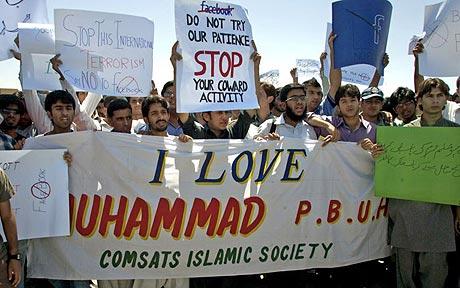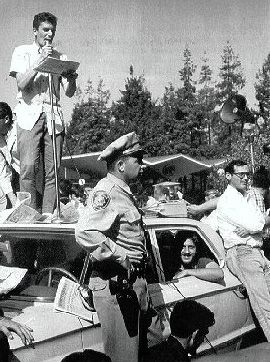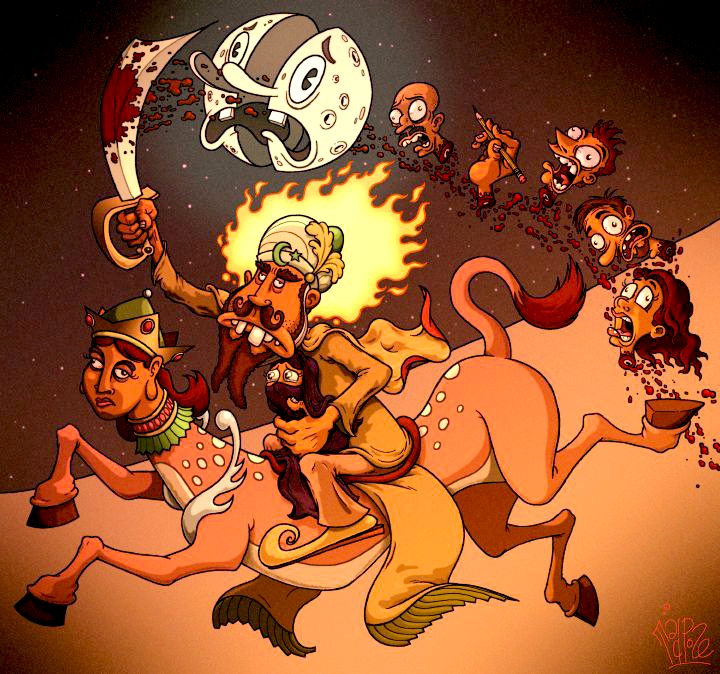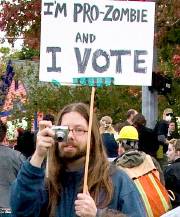Archive for May 2010
My latest report from the front lines:
The Stench of Elitism Hung Heavy in the Air
Barack Obama returned triumphant to San Francisco on Tuesday and was welcomed by throngs of cheering supporters.
…
Not.
You’d think he’d receive a hero’s homecoming, considering that San Francisco is the most liberal big city in the nation and its residents voted for him in overwhelming numbers. But in stark reality, here’s the full extent of the cheering section that awaited him:
A grand total of two people.Incredible as it may seem, these were the only two identifiably pro-Obama demonstrators I saw all day. On the other hand, there were hundreds upon hundreds of fiercely anti-Obama protesters, attacking him from…
..the left, and…
…the right.How did we get here? Let’s go back to the beginning of the day and tell the story chronologically.
…
And another photo from later in the report to whet your appetite:
Read the rest here!
Today is Everybody Draw Mohammed Day, a completely made-up satirical “holiday” dedicated to the concept of drawing Mohammed cartoons, as a way of making a statement about freedom of speech.
Not everyone agrees with this idea, however. And I’m not just talking about the expected naysayers — that is, fundamentalist Muslims (who demand that no one be allowed to depict their prophet) and progressive multiculturalists (who run interference for fundamentalist Muslims by insisting that we all obey Islamic demands or risk being branded as racists).
No, even some level-headed conservative-leaning pundits have begun to cast aspersions on this whole Mohammed cartoon thing. Most notable among them is J.E. Dyer, whose recent article posted at HotAir entitled “Provocation isn’t the highest form of free speech” made the argument that mocking Mohammed is basically pointless “provocation” and that, although provocative speech is protected, it is the embarrassing stepchild of the noble, high-toned political speech imagined by our forefathers, and as such should be avoided lest we come off as brutes and rubes. To quote the key passage of Dyer’s thesis,
The right to offend others is something that gets a pass because of the good that comes from the better, higher, more important right to make our own philosophical decisions. The right to be deliberately offensive is a parasite, not a first principle.
I disagree. Strongly. And I’ll tell you why.
Who Decides What Is Provocative?
 |
| Protesters in Pakistan yesterday, angry about the Everybody Draw Mohammed Day Facebook page |
This is not an argument over the right to be “provocative” or “offensive”; rather, is it something much more significant — an argument over who gets to determine what counts as provocative or offensive in the first place. The Western world dragged itself out of the church-dominated Dark Ages and into the Enlightenment in part over this precise issue: the freedom to engage in speech and actions which formerly had been classified as the crime known as “blasphemy.” It seems such a trivial and quaint issue in retrospect, and hardly worthy of note from our hyper-secularized 21st-century perspective, but tell that to the millions of people who for centuries lived under the yoke of governments which used accusations of blasphemy and other religious misbehaviors as a primary tool of tyranny and oppression. The modern world dawned with the American and French Revolutions and the emergence of the explicitly secular state — the Americans rejecting the Church of England as Britain’s legally enforced national religion, and the French shrugging off centuries of acquiescence to domination by the Catholic Church in civil affairs. In both cases, new governmental paradigms were established in which there was an inviolable separation of church and state, which in practice meant no civil laws enforcing religious doctrines and (most importantly for our discussion) no laws against blasphemy.
 |
| The original “Draw Winky” ad from a 1971 comic book |
We’re now so accustomed to this liberated society that we have all but forgotten how horrible it was in the Bad Old Days before our Founding Fathers (wipes away tear) created a safe haven for the human mind, a place called the United States of America. The laws and punishments of the Puritans and of the Spanish Inquisition and all the rest were decisively and emphatically swept off the table and replaced with a simple principle: personal freedom. Freedom of conscience, freedom of thought, and freedom of speech.
Everybody Expects the Islamic Inquisition
Well, the Spanish Inquisition may be a distant memory now relegated to Monty Python skits, but the self-appointed Islamic Inquisition is threatening to take its place. Remember that the Spanish Inquisition (and the much larger papal inquisition which preceded it) existed for the purpose of enforcing religious dictates on the general populace, including and especially religious crimes such as heresy, blasphemy, and apostasy. Punishment for these deeds could be severe and often as not included torture or execution. This is exactly what the Islamic fundamentalists want to impose on us in the 21st century: Obedience to religious dictates, enforced where necessary by violence.
Luckily, outside of a few Middle Eastern countries, the Islamists do not have the power to enforce their hellish vision of society. But that doesn’t stop them from trying. Where they can’t impose their religious rules by force, they try to impose them by fear and intimidation. Since we have our freedoms permanently etched into our Constitution, the Islamists are going to have little luck getting blasphemy laws passed in the U.S. Yet they can achieve the same result if they can use terror to bring about our own self-censorship. Which is exactly what they have set about doing, the most recent round starting with the murder of Theo Van Gogh in 2004 and reaching the boiling point with the Danish Cartoon Controversy in 2006. The pot hasn’t stopped boiling since. The Islamists’ strategy is to kill, or threaten to kill, anyone who gets media attention for “disrespecting” Islam or Mohammed — thereby convincing the rest of us infidels to remain silent if we know what’s good for us.
 |
| Updated 2010 version of “Draw Winky” (parody by buzzsawmonkey) |
And here we come to the crux of the matter. Which side in this conflict gets to determine what counts as “disrespectful” (a contemporary euphemism for “blasphemous”)? In the jihadists’ view, any depiction of Mohammed — even a positive or honorific depiction — is deemed blasphemous. It’s our religion, they say, so we get to say what’s offensive. Yet if we grant them this inch, they’ll take another inch (it’s also disrespectful to write Mohammed’s name without a worshipful “PBUH” after it), and another inch (it’s disrespectful to criticize Islam in any way), and before long it’s the whole mile, and we once again will be living in an intellectual Middle Ages in which religious tyrants dictate our every thought and action.
So you can see the urge of every sane-minded Westerner to say a hearty Fuck you! to anyone who tries to erode away the bedrock of our free society. The more insistent (and violent) these attempts at erosion, the less civil the resistance will become. Which is exactly as it should be. If the Islamists want us to to stop mocking (or even questioning) Mohammed, they can achieve this goal quite simply: Just go away and leave us alone. Don’t bother us, and we won’t bother you. Seriously, 99% of non-Muslims don’t give a good goddamn about Mohammed one way or the other, and we’d gladly ignore him and his followers until the end of time — if they’d just stop trying to boss us around. But if someone comes to our safe haven and tries to impose a repressive or restrictive rule on us, then that is the exact rule we’re going to flout until the interlopers learn their lesson: We don’t take kindly to bullshit medieval religious oppression in these parts.
And so we return to J.E. Dyer’s essay, where she essentially argues that freedom of speech is simply the vehicle through which we can express our political ideals without fear of reprisal. While that may be true, it leaves out the final piece of the puzzle: Freedom of speech itself is our highest political ideal. We need freedom of speech not merely so we can discuss Aristotle and the Teapot Dome Scandal and non-proliferation treaties, but more importantly we need freedom of speech so we can defend the unconditional right of freedom to speak — or think, or draw, for that matter. As soon as someone comes along and says (as Dyer does) that some forms of speech are “better” or “higher” than others, the implication is that the the low-class expressions are somehow less worthy of defending. But that way lies the road to ruin. We would soon begin to slide down what I call Niemöller’s Slippery Slope, which in this instance would begin, “First they came for the cartoonists….”
It is precisely the most offensive speech which needs to be defended, because that is the only speech which ever gets challenged in the first place. If we cave in on this seemingly trivial issue, we have already lost.
 |
| Mario Savio in 1964 helped launch the Free Speech Movement into national consciousness by climbing atop a police car at U.C. Berkeley and denouncing campus rules which prohibited political speech |
The New Free Speech Movement
And it is often on the most trivial of points that history pivots. Take, for example, the original Free Speech Movement of the mid-1960s, which was the fuse that ignited the social transformations in the second half of that decade. At first, the initial dispute was over something as ridiculous as which student groups were allowed to have a literature table on U.C. Berkeley’s Sproul Plaza, and whether or not the sidewalk bordering the campus counted as university property (where leafletting would be banned) or city property (where it would be allowed). Hardly something worth getting worked up over. But the students pressed the issue, and pressed, and eventually an utterly trivial local dispute became a not-so-trivial local dispute, and when the University caved in, it opened the floodgates to student activism and social upheaval first at Berkeley and eventually across the nation (and world, for that matter).
I posit that this cartoon fiasco may look as trivial now as did the silly Berkeley sidewalk dispute back in 1964, but it could very well morph into a new Free Speech Movement which could affect the course of history just as much as did the first one.
The Mohammed cartoons — whether they appear in a Danish newspaper, on South Park, on Everybody Draw Mohammed Day, or anywhere else, are basically our way of saying, Bring it on. They are an intentional goading to accelerate the inevitable clash of civilizations: totalitarianism vs. democracy, religion vs. secularism, repression vs. freedom, Islam vs. the liberal West — choose your definitions. It’s coming, whether we like it or not. And it’s quite apparent to the Mohammed cartoonists and their supporters that, currently, Team Islam does not have the tools to win. Philosophically, militarily, financially, analytically, morally and in just about every other way they have a losing hand. But the crazy part is, they don’t seem to realize it quite yet. So, from a strategic standpoint, if your opponent is overconfident and bound to lose yet still itching for a fight, it’s best to let him engage now and get defeated, than wait for some future day of conflict where the outcome may be in doubt.
Islamic extremists still seem to think that banning Facebook or threatening to kill the Everybody Draw Mohammed Day organizers will somehow make the problem of blasphemy go away. They don’t yet understand that we in the West have spent the last 600 years not merely earning the right to be blasphemous, but more importantly creating a society and a worldview in which there is no such thing as blasphemy, because all forms of speech are permitted and religious bullies no longer get to determine what is forbidden.
Now get out your pencils and start drawing.
UPDATE
Over the last few hours I’ve received an avalanche of Mohammed cartoon submissions in response to the Everybody Draw Mohammed Day “contest.” And even though it isn’t a real contest (and even if it was a competition I am not the organizer nor any kind of “judge”), I did just receive a submission which stands out as far and away the most eye-catching of the bunch. If I was a judge, this Mohammed cartoon, by an anonymous artist who wishes to go by the name “Tad Pole,” is currently my favorite to be deemed the “winner” of today’s Draw Mohammed contest:

On a recent trip to Berkeley I was traveling down College Avenue and noticed something which caused me to raise an eyebrow:
At the intersection of College and Derby are two buildings: On the left is the Julia Morgan Theater, a popular performance space for plays, musicals and concerts; and on the right is Chabad House, the East Bay headquarters of the Chabad-Lubavitch Hasidic movement, which also functions as a local Jewish community center.
The buildings have been standing across the street from each other for decades, without the slightest whiff of controversy or animosity.
But as you can see from the photo, the current production at the Julia Morgan Theater is Oliver!, the musical based on Dickens’ Oliver Twist, and to advertise the show, the producers placed a huge banner out front depicting Fagin, one of the lead characters.
Here’s a split-screen closeup, showing the Fagin banner more clearly on the left, and the Chabad banner more clearly on the right.
This wouldn’t be particularly noteworthy except that Fagin is considered to be an insulting anti-Semitic stereotype, and the banner was positioned to face directly toward Chabad House across the street. When the Chabadniks look out the building’s front windows, they have to gaze directly at a 10-foot-tall image of a stereotypical “greedy Jew.”
Now, while it may be true that the script for Oliver! tones down the anti-Semitic aspect of Fagin’s character and treats him more as comic relief than a villain, in the original editions of Oliver Twist Fagin is completely despicable, and is considered by many to be the most anti-Semitic literary character of the 19th century.
While I can only assume that the juxtaposition of the Fagin banner and the Chabad House was inadvertent, somewhere in the back of my mind I still have the nagging feeling that maybe, just maybe, it wasn’t entirely coincidental after all.
Lars Vilks, a Swedish artist, sketched some caricatures of Mohammed as a dog back in 2007, and for his efforts earned himself a fatwa — a death sentence issued by the good clerics of Al Qaeda in Iraq for the capital crime of depicting Islam’s prophet. Today that death sentence was nearly carried out as Vilks was assaulted (by a Muslim screaming “Allahu Ackbar!”) while giving a lecture in Uppsala, Sweden about his experiences with censorship. Luckily, Vilks survived; unluckily, he was headbutted directly in his face by the attacker; Vilks’ glasses were smashed, but police were on hand to prevent the follow-up beheading which the fatwa-givers had called for.
A Swedish TV station was on hand and managed to catch the attack on video:
What you actually see here is the immediate aftermath of the attack: the cameraman missed the headbutt by a second or two, and by the time the camera pans down from the screen, Vilks is already crumpling to the floor and the attacker is trying to dodge his way out of the police’s grasp.
But the video is remarkable in a different way: It shows dozens of Muslims repeatedly screaming “Allahu Ackbar” in what looks like religious ecstasy over violence committed in their name, and joy over witnessing an attempted murder as punishment for blasphemy.
This happened today in Sweden, mind you, not during the Middle Ages nor even in 2001 in Taliban-controlled Afghanistan. Right now, in what is supposed to be the most liberal and progressive nation in the world.
Coverage of the Incident
Reason magazine seems to have been the ones who broke the story in the English-speaking world; it was quickly picked up by HotAir, which reminds us that recently arrested would-be terrorist “Jihad Jane” was plotting to kill Vilks over his sketches. The Jawa Report captured a screenshot of a Muslim woman on Facebook saying of Vilks “I would have shot him” rather than merely headbutt him.
And the mainstream media? To its eternal shame, in the BBC’s coverage of this incident they refer to Mohammed (as they are required to refer to Mohammed as part of the BBC’s style guidelines) as “the Prophet Muhammad”, with the epithet “Prophet” preceding his name in each instance. Does the BBC similarly refer to Jesus Christ as “The Messiah” or “Our Lord and Savior Jesus Christ” or even “Jesus the Christ”? No. Due to abject fear and groveling cowardice, they use one religion’s own descriptor for their founder, but not any other religions’ descriptors for their founders.
The Backstory
I covered Lars Vilks extensively back in 2007 with a special entry in the Mohammed Image Archive. For those mystified as to what the heck a “roundabout dog” even is, my Archive captions make it all clear:
In the nation of Sweden there is a contemporary urban folk custom of placing in the center of “roundabouts” (the circular traffic islands in the middle of major intersections) whimsical homemade sculptures representing pet dogs. The sculptures, which are fairly commonplace in Sweden, are called “roundabout dogs” (rondellhund in Swedish). In the summer of 2007, Swedish artist Lars Vilks made some paintings of Mohammed as a roundabout dog; after they were rejected by two art galleries wary of controversy, a sketch based on one of the paintings ended up being published in a small local Swedish newspaper, Nerikes Allehanda. Incredibly, this ignited an international furor, with protests, diplomatic quarrels, and threats of violence. The original sketch, seen above, was also posted on Vilks’ blog.
Over the following month, Vilks continued to draw additional sketches of Mohammed as a roundabout dog, as a regular dog, and as a human in various satirical settings, and posted them to his blog on July 21, July 22, July 23, July 25, July 26, July 27, July 29, July 30, August 11, August 13, and August 18.

More details about the original 2007 international furor can be found at these links:
The Lars Vilks Muhammad drawings controversy, at wikipedia.
Newspaper article in Swedish about the beginnings of the incident.
Turkish hackers attacked Swedish Web sites as retaliation for the roundabout dog Mohammed.
If you’re as outraged by this ever-escalating terror campaign against artists as you ought to be, remember to disseminate and repost any and all images of your choosing from the Mohammed Image Archive, which (as noted in my earlier post) contains just about every picture of Mohammed ever created.
For maximum blasphemy, start using mocons (Mohammed Icons) instead of smiley-faces:
Mohammed (((:~{>
Mohammed as a pirate (((P~{>
Mohammed on a bad turban day ))):~{>
Mohammed with sand in his eye (((;~{>
Mohammed wearing sunglasses (((B~{>
Mohammed with a lit bomb in his turban *-O)):~{>
The devil mo ]:~{>
Mohammed with a nuclear bomb in his turban. @=(((:~{>
Mohammed being shot by Starship Enterprise =-o * * * (((:~{>
Mohammed sees a Danish (or Swedish) cartoonist !((((8~{o>
Mocons are the most efficient way to digitally propagate the maximum amount of Mohammed imagery per byte.

 (Note: This is not a photo of me, but rather
(Note: This is not a photo of me, but rather